Input interpretation

Br_2 bromine + CH_4 methane ⟶ HBr hydrogen bromide + CBr_4 carbon tetrabromide
Balanced equation
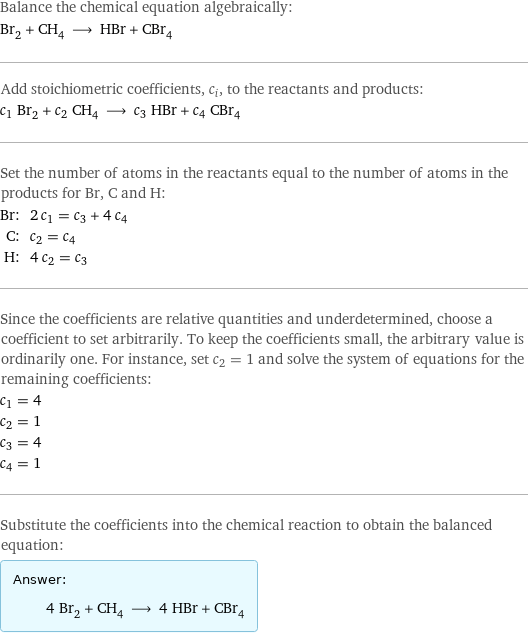
Balance the chemical equation algebraically: Br_2 + CH_4 ⟶ HBr + CBr_4 Add stoichiometric coefficients, c_i, to the reactants and products: c_1 Br_2 + c_2 CH_4 ⟶ c_3 HBr + c_4 CBr_4 Set the number of atoms in the reactants equal to the number of atoms in the products for Br, C and H: Br: | 2 c_1 = c_3 + 4 c_4 C: | c_2 = c_4 H: | 4 c_2 = c_3 Since the coefficients are relative quantities and underdetermined, choose a coefficient to set arbitrarily. To keep the coefficients small, the arbitrary value is ordinarily one. For instance, set c_2 = 1 and solve the system of equations for the remaining coefficients: c_1 = 4 c_2 = 1 c_3 = 4 c_4 = 1 Substitute the coefficients into the chemical reaction to obtain the balanced equation: Answer: | | 4 Br_2 + CH_4 ⟶ 4 HBr + CBr_4
Structures

+ ⟶ +
Names

bromine + methane ⟶ hydrogen bromide + carbon tetrabromide
Reaction thermodynamics
Enthalpy
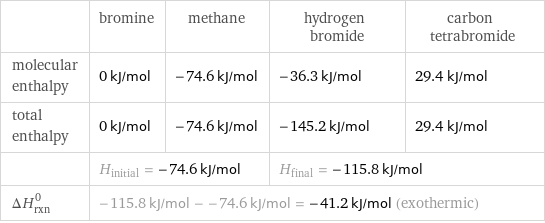
| bromine | methane | hydrogen bromide | carbon tetrabromide molecular enthalpy | 0 kJ/mol | -74.6 kJ/mol | -36.3 kJ/mol | 29.4 kJ/mol total enthalpy | 0 kJ/mol | -74.6 kJ/mol | -145.2 kJ/mol | 29.4 kJ/mol | H_initial = -74.6 kJ/mol | | H_final = -115.8 kJ/mol | ΔH_rxn^0 | -115.8 kJ/mol - -74.6 kJ/mol = -41.2 kJ/mol (exothermic) | | |
Gibbs free energy
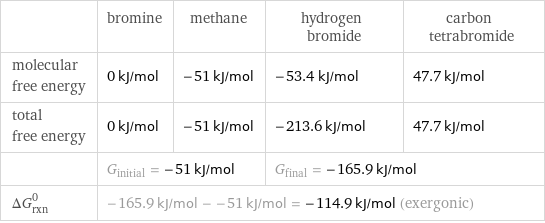
| bromine | methane | hydrogen bromide | carbon tetrabromide molecular free energy | 0 kJ/mol | -51 kJ/mol | -53.4 kJ/mol | 47.7 kJ/mol total free energy | 0 kJ/mol | -51 kJ/mol | -213.6 kJ/mol | 47.7 kJ/mol | G_initial = -51 kJ/mol | | G_final = -165.9 kJ/mol | ΔG_rxn^0 | -165.9 kJ/mol - -51 kJ/mol = -114.9 kJ/mol (exergonic) | | |
Equilibrium constant
![Construct the equilibrium constant, K, expression for: Br_2 + CH_4 ⟶ HBr + CBr_4 Plan: • Balance the chemical equation. • Determine the stoichiometric numbers. • Assemble the activity expression for each chemical species. • Use the activity expressions to build the equilibrium constant expression. Write the balanced chemical equation: 4 Br_2 + CH_4 ⟶ 4 HBr + CBr_4 Assign stoichiometric numbers, ν_i, using the stoichiometric coefficients, c_i, from the balanced chemical equation in the following manner: ν_i = -c_i for reactants and ν_i = c_i for products: chemical species | c_i | ν_i Br_2 | 4 | -4 CH_4 | 1 | -1 HBr | 4 | 4 CBr_4 | 1 | 1 Assemble the activity expressions accounting for the state of matter and ν_i: chemical species | c_i | ν_i | activity expression Br_2 | 4 | -4 | ([Br2])^(-4) CH_4 | 1 | -1 | ([CH4])^(-1) HBr | 4 | 4 | ([HBr])^4 CBr_4 | 1 | 1 | [CBr4] The equilibrium constant symbol in the concentration basis is: K_c Mulitply the activity expressions to arrive at the K_c expression: Answer: | | K_c = ([Br2])^(-4) ([CH4])^(-1) ([HBr])^4 [CBr4] = (([HBr])^4 [CBr4])/(([Br2])^4 [CH4])](../image_source/46a2b9567960c9fc33c440d5fdc15a04.png)
Construct the equilibrium constant, K, expression for: Br_2 + CH_4 ⟶ HBr + CBr_4 Plan: • Balance the chemical equation. • Determine the stoichiometric numbers. • Assemble the activity expression for each chemical species. • Use the activity expressions to build the equilibrium constant expression. Write the balanced chemical equation: 4 Br_2 + CH_4 ⟶ 4 HBr + CBr_4 Assign stoichiometric numbers, ν_i, using the stoichiometric coefficients, c_i, from the balanced chemical equation in the following manner: ν_i = -c_i for reactants and ν_i = c_i for products: chemical species | c_i | ν_i Br_2 | 4 | -4 CH_4 | 1 | -1 HBr | 4 | 4 CBr_4 | 1 | 1 Assemble the activity expressions accounting for the state of matter and ν_i: chemical species | c_i | ν_i | activity expression Br_2 | 4 | -4 | ([Br2])^(-4) CH_4 | 1 | -1 | ([CH4])^(-1) HBr | 4 | 4 | ([HBr])^4 CBr_4 | 1 | 1 | [CBr4] The equilibrium constant symbol in the concentration basis is: K_c Mulitply the activity expressions to arrive at the K_c expression: Answer: | | K_c = ([Br2])^(-4) ([CH4])^(-1) ([HBr])^4 [CBr4] = (([HBr])^4 [CBr4])/(([Br2])^4 [CH4])
Rate of reaction
![Construct the rate of reaction expression for: Br_2 + CH_4 ⟶ HBr + CBr_4 Plan: • Balance the chemical equation. • Determine the stoichiometric numbers. • Assemble the rate term for each chemical species. • Write the rate of reaction expression. Write the balanced chemical equation: 4 Br_2 + CH_4 ⟶ 4 HBr + CBr_4 Assign stoichiometric numbers, ν_i, using the stoichiometric coefficients, c_i, from the balanced chemical equation in the following manner: ν_i = -c_i for reactants and ν_i = c_i for products: chemical species | c_i | ν_i Br_2 | 4 | -4 CH_4 | 1 | -1 HBr | 4 | 4 CBr_4 | 1 | 1 The rate term for each chemical species, B_i, is 1/ν_i(Δ[B_i])/(Δt) where [B_i] is the amount concentration and t is time: chemical species | c_i | ν_i | rate term Br_2 | 4 | -4 | -1/4 (Δ[Br2])/(Δt) CH_4 | 1 | -1 | -(Δ[CH4])/(Δt) HBr | 4 | 4 | 1/4 (Δ[HBr])/(Δt) CBr_4 | 1 | 1 | (Δ[CBr4])/(Δt) (for infinitesimal rate of change, replace Δ with d) Set the rate terms equal to each other to arrive at the rate expression: Answer: | | rate = -1/4 (Δ[Br2])/(Δt) = -(Δ[CH4])/(Δt) = 1/4 (Δ[HBr])/(Δt) = (Δ[CBr4])/(Δt) (assuming constant volume and no accumulation of intermediates or side products)](../image_source/3f3f41b7e586799efe644fd841e1882f.png)
Construct the rate of reaction expression for: Br_2 + CH_4 ⟶ HBr + CBr_4 Plan: • Balance the chemical equation. • Determine the stoichiometric numbers. • Assemble the rate term for each chemical species. • Write the rate of reaction expression. Write the balanced chemical equation: 4 Br_2 + CH_4 ⟶ 4 HBr + CBr_4 Assign stoichiometric numbers, ν_i, using the stoichiometric coefficients, c_i, from the balanced chemical equation in the following manner: ν_i = -c_i for reactants and ν_i = c_i for products: chemical species | c_i | ν_i Br_2 | 4 | -4 CH_4 | 1 | -1 HBr | 4 | 4 CBr_4 | 1 | 1 The rate term for each chemical species, B_i, is 1/ν_i(Δ[B_i])/(Δt) where [B_i] is the amount concentration and t is time: chemical species | c_i | ν_i | rate term Br_2 | 4 | -4 | -1/4 (Δ[Br2])/(Δt) CH_4 | 1 | -1 | -(Δ[CH4])/(Δt) HBr | 4 | 4 | 1/4 (Δ[HBr])/(Δt) CBr_4 | 1 | 1 | (Δ[CBr4])/(Δt) (for infinitesimal rate of change, replace Δ with d) Set the rate terms equal to each other to arrive at the rate expression: Answer: | | rate = -1/4 (Δ[Br2])/(Δt) = -(Δ[CH4])/(Δt) = 1/4 (Δ[HBr])/(Δt) = (Δ[CBr4])/(Δt) (assuming constant volume and no accumulation of intermediates or side products)
Chemical names and formulas
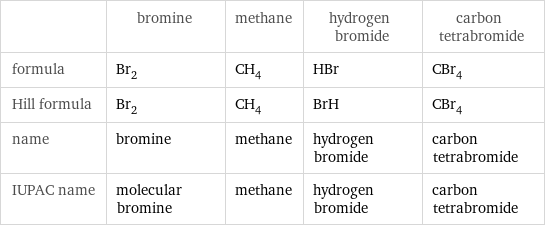
| bromine | methane | hydrogen bromide | carbon tetrabromide formula | Br_2 | CH_4 | HBr | CBr_4 Hill formula | Br_2 | CH_4 | BrH | CBr_4 name | bromine | methane | hydrogen bromide | carbon tetrabromide IUPAC name | molecular bromine | methane | hydrogen bromide | carbon tetrabromide
Substance properties
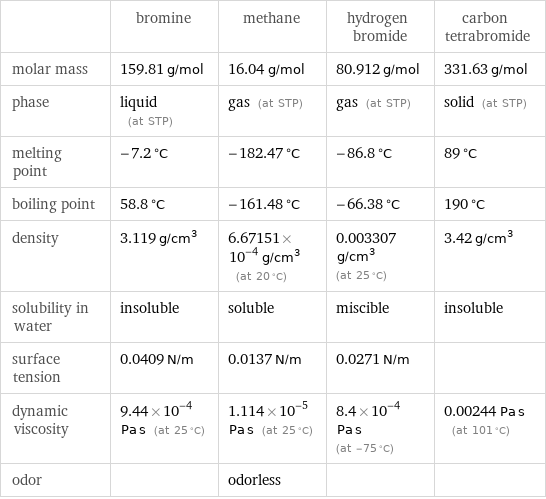
| bromine | methane | hydrogen bromide | carbon tetrabromide molar mass | 159.81 g/mol | 16.04 g/mol | 80.912 g/mol | 331.63 g/mol phase | liquid (at STP) | gas (at STP) | gas (at STP) | solid (at STP) melting point | -7.2 °C | -182.47 °C | -86.8 °C | 89 °C boiling point | 58.8 °C | -161.48 °C | -66.38 °C | 190 °C density | 3.119 g/cm^3 | 6.67151×10^-4 g/cm^3 (at 20 °C) | 0.003307 g/cm^3 (at 25 °C) | 3.42 g/cm^3 solubility in water | insoluble | soluble | miscible | insoluble surface tension | 0.0409 N/m | 0.0137 N/m | 0.0271 N/m | dynamic viscosity | 9.44×10^-4 Pa s (at 25 °C) | 1.114×10^-5 Pa s (at 25 °C) | 8.4×10^-4 Pa s (at -75 °C) | 0.00244 Pa s (at 101 °C) odor | | odorless | |
Units
